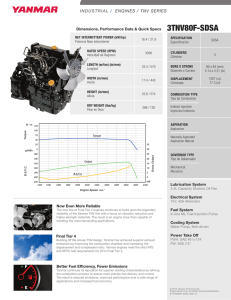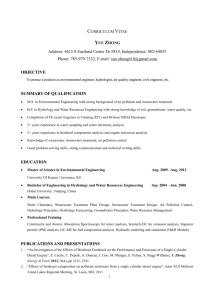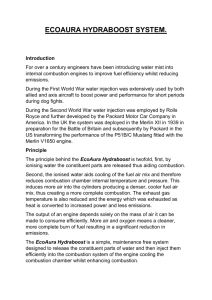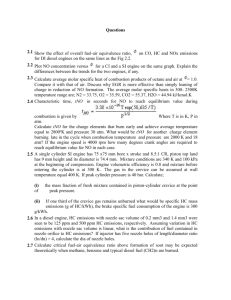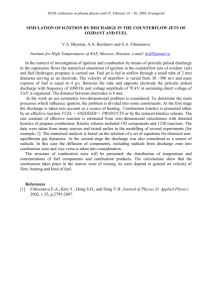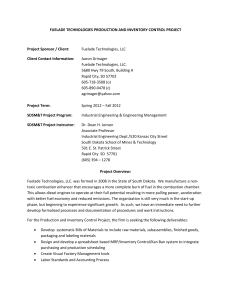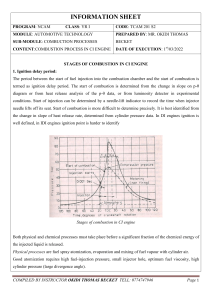fullPaper
advertisement
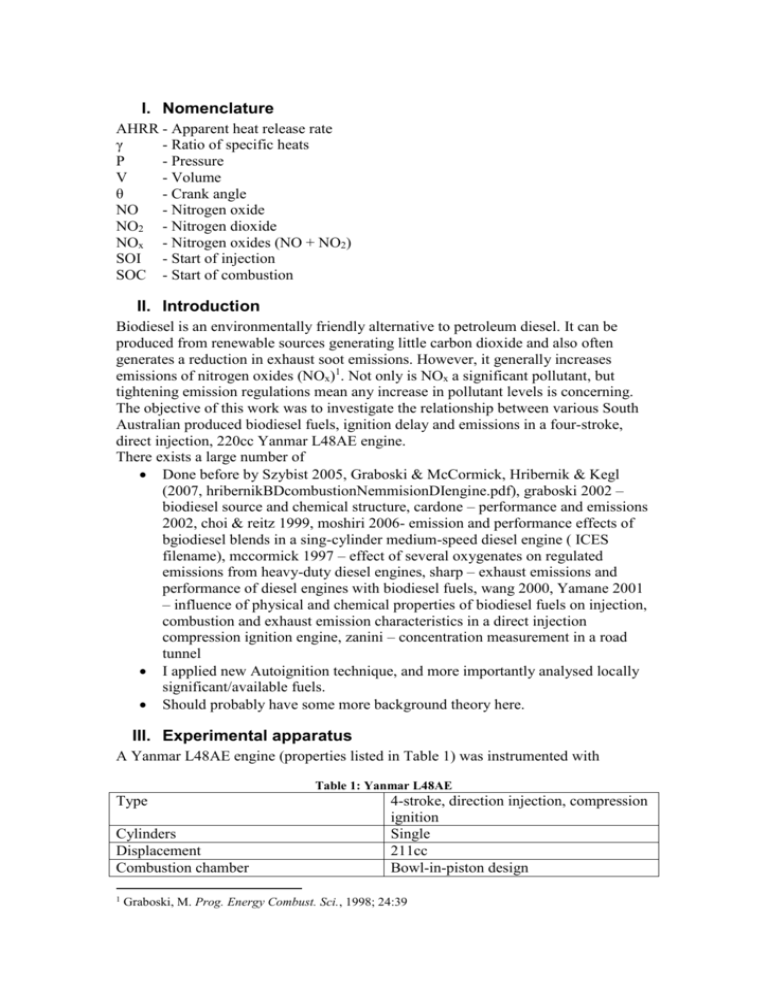
I. Nomenclature AHRR - Apparent heat release rate γ - Ratio of specific heats P - Pressure V - Volume θ - Crank angle NO - Nitrogen oxide NO2 - Nitrogen dioxide NOx - Nitrogen oxides (NO + NO2) SOI - Start of injection SOC - Start of combustion II. Introduction Biodiesel is an environmentally friendly alternative to petroleum diesel. It can be produced from renewable sources generating little carbon dioxide and also often generates a reduction in exhaust soot emissions. However, it generally increases emissions of nitrogen oxides (NOx)1. Not only is NOx a significant pollutant, but tightening emission regulations mean any increase in pollutant levels is concerning. The objective of this work was to investigate the relationship between various South Australian produced biodiesel fuels, ignition delay and emissions in a four-stroke, direct injection, 220cc Yanmar L48AE engine. There exists a large number of Done before by Szybist 2005, Graboski & McCormick, Hribernik & Kegl (2007, hribernikBDcombustionNemmisionDIengine.pdf), graboski 2002 – biodiesel source and chemical structure, cardone – performance and emissions 2002, choi & reitz 1999, moshiri 2006- emission and performance effects of bgiodiesel blends in a sing-cylinder medium-speed diesel engine ( ICES filename), mccormick 1997 – effect of several oxygenates on regulated emissions from heavy-duty diesel engines, sharp – exhaust emissions and performance of diesel engines with biodiesel fuels, wang 2000, Yamane 2001 – influence of physical and chemical properties of biodiesel fuels on injection, combustion and exhaust emission characteristics in a direct injection compression ignition engine, zanini – concentration measurement in a road tunnel I applied new Autoignition technique, and more importantly analysed locally significant/available fuels. Should probably have some more background theory here. III. Experimental apparatus A Yanmar L48AE engine (properties listed in Table 1) was instrumented with Table 1: Yanmar L48AE Type Cylinders Displacement Combustion chamber 1 4-stroke, direction injection, compression ignition Single 211cc Bowl-in-piston design Graboski, M. Prog. Energy Combust. Sci., 1998; 24:39 Bore X Stroke 70mm X 55mm Fuel injection In line pump Fuel injection pump timing 14±1° BTDC Fuel injection pressure 19.6MPa Maximum engine speed (no load) 3800RPM Maximum output 3.5kW Cooling Air The engine was loaded using a simple magnetic brake and the tangential force from this magnetic calliper was measured to determine torque output. A burette was gravity fed from the fuel tank and (by closing a valve in the fuel line) measures the volumetric fuel consumption. Cylinder and fuel line pressure was recorded with PCB Piezotronic 112B11 sensors sampled at 1MS/sec with 12-bit resolution. The data was ensemble averaged over at least 700 cycles to minimise filtering. A simple Savitsky-Golay filter was implemented to smooth the data before the pressure trace was differentiated for the AHRR calculation described below. Ideal gas and constant specific heat ratio assumptions can introduce errors in diesel simulations2. Hence an iterative temperature calculation using the thermodynamic relation (1) was used, with γ calculated from NASA thermodynamic tables3, and gas composition for dry air from Moran and Shapiro4, with humidity accounted for by a wet-bulb/dry-bulb measurement performed during data collection. 1 P Ti Ti 1 i (1) Pi 1 The initial temperature of the cylinder charge was estimated as 330° Kelvin using a Ricardo WAVE simulation of the engine. The AHRR is a common calculation which highlights combustion characteristics. As can be seen in (2)5, it involves the differentials of both pressure and volume. Pressure was found from the filtered pressure signal, while volume was calculated from engine geometry and a crank angle sensor signal, with a resolution of 2000 points per cycle. dV 1 dP (2) AHRR P V 1 d 1 d Ignition delay is defined as the time between the start of injection (SOI) and the start of combustion (SOC)5. Opening pressure of the injector was determined as 20.0MPa by using a poppet valve tester. The SOI was defined as when pressure in the fuel line (measured as close as was practical to the injector) exceeded 20.0MPa. Using the high-pressure speed of sound measurements by Tat6, the maximum delay between the pressure wave reaching the transducer and the injector opening was approximately 0.02ms, and was considered negligible. SOC was originally determined using the first moment of positive heat release, however this criterion was changed to the maximum of the third differential of 2 Musculus, M. SAE Special Publication SP-1974, 2005 Smith, G.P. et al. http://www.me.berkeley.edu/gri_mech 4 Moran, M.J. and Shapiro, H.N. Fundamentals of Engineering Thermodynamics, Jon Wiley & Sons Inc., New York; 1999 5 Heywood, J.B. Internal Combustion Engine Fundamentals, McGraw Hill Inc., Singapore; 1988 6 Tat, M.E. Investigation of oxides of nitrogen emissions from biodiesel-fueled engines, Ph.D. Thesis, Iowa State University, Iowa; 2003 3 pressure (as recommended by Katrasnik7) for a more repeatable SOC measurement. Emissions (O2, CO, NO, NO2, and unburnt hydrocarbons) were monitored using a Testo 350 XL gas analyser sampling at the muffler’s exit. Particulate matter was measured with a MAHA DPMS 04 particulate measurement system, which uses a laser light scattering photometer. The accuracy of each variable reported is shown in Table 2. 7 Katrašnik, T. et al.J. Eng. Gas Turbines and Power 128 (1); 2006 Table 2: Accuracies Measurement NO, NO2, CO Oxygen Particulate matter SOI, SOC Ignition delay Temperature Pressure Accuracy ±5% of measurement value ±0.8% concentration ±1mg/m3 ±2° crank angle ±0.01ms ±30°K ±5kPa
